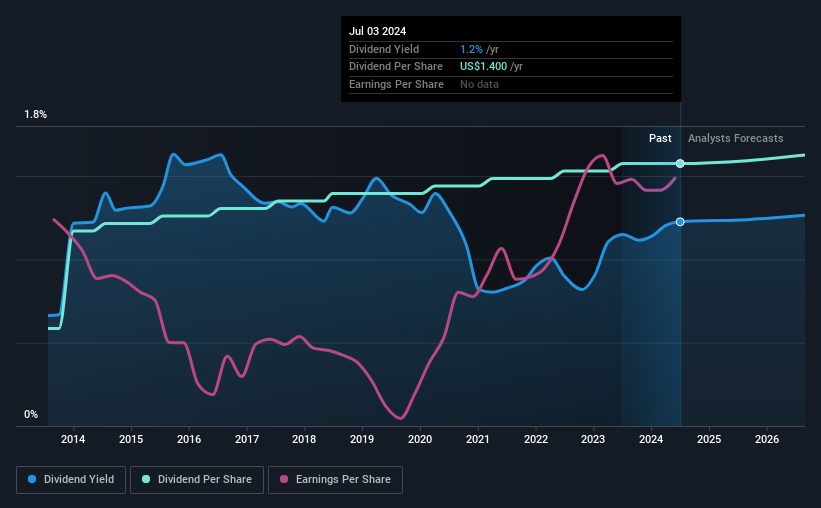Lindsay's (NYSE:LNN) Shareholders Will Receive A Bigger Dividend Than Last Year
The board of Lindsay Corporation (NYSE:LNN) has announced that the dividend on 30th of August will be increased to $0.36, which will be 2.9% higher than last year's payment of $0.35 which covered the same period. Although the dividend is now higher, the yield is only 1.2%, which is below the industry average.
View our latest analysis for Lindsay
Lindsay's Earnings Easily Cover The Distributions
It would be nice for the yield to be higher, but we should also check if higher levels of dividend payment would be sustainable. However, Lindsay's earnings easily cover the dividend. As a result, a large proportion of what it earned was being reinvested back into the business.
Looking forward, earnings per share is forecast to fall by 0.4% over the next year. If the dividend continues along recent trends, we estimate the payout ratio could be 22%, which we consider to be quite comfortable, with most of the company's earnings left over to grow the business in the future.
Lindsay Has A Solid Track Record
The company has a sustained record of paying dividends with very little fluctuation. The annual payment during the last 10 years was $0.52 in 2014, and the most recent fiscal year payment was $1.40. This works out to be a compound annual growth rate (CAGR) of approximately 10% a year over that time. It is good to see that there has been strong dividend growth, and that there haven't been any cuts for a long time.
The Dividend Looks Likely To Grow
Some investors will be chomping at the bit to buy some of the company's stock based on its dividend history. Lindsay has seen EPS rising for the last five years, at 66% per annum. Earnings have been growing rapidly, and with a low payout ratio we think that the company could turn out to be a great dividend stock.
Lindsay Looks Like A Great Dividend Stock
Overall, a dividend increase is always good, and we think that Lindsay is a strong income stock thanks to its track record and growing earnings. The earnings easily cover the company's distributions, and the company is generating plenty of cash. If earnings do fall over the next 12 months, the dividend could be buffeted a little bit, but we don't think it should cause too much of a problem in the long term. Taking this all into consideration, this looks like it could be a good dividend opportunity.
It's important to note that companies having a consistent dividend policy will generate greater investor confidence than those having an erratic one. However, there are other things to consider for investors when analysing stock performance. Earnings growth generally bodes well for the future value of company dividend payments. See if the 4 Lindsay analysts we track are forecasting continued growth with our free report on analyst estimates for the company. Looking for more high-yielding dividend ideas? Try our collection of strong dividend payers.
Have feedback on this article? Concerned about the content? Get in touch with us directly. Alternatively, email editorial-team (at) simplywallst.com.
This article by Simply Wall St is general in nature. We provide commentary based on historical data and analyst forecasts only using an unbiased methodology and our articles are not intended to be financial advice. It does not constitute a recommendation to buy or sell any stock, and does not take account of your objectives, or your financial situation. We aim to bring you long-term focused analysis driven by fundamental data. Note that our analysis may not factor in the latest price-sensitive company announcements or qualitative material. Simply Wall St has no position in any stocks mentioned.
Have feedback on this article? Concerned about the content? Get in touch with us directly. Alternatively, email editorial-team@simplywallst.com

 Yahoo Finance
Yahoo Finance 
